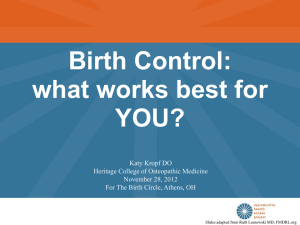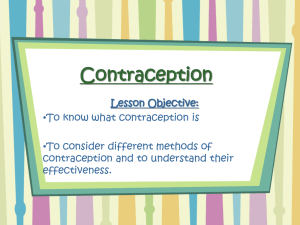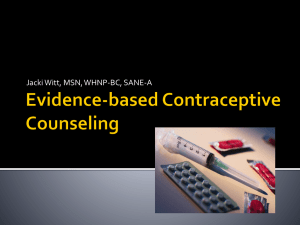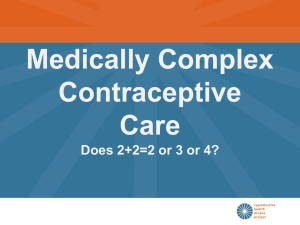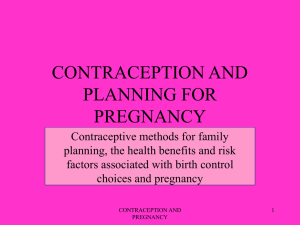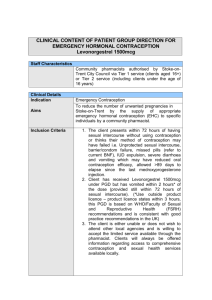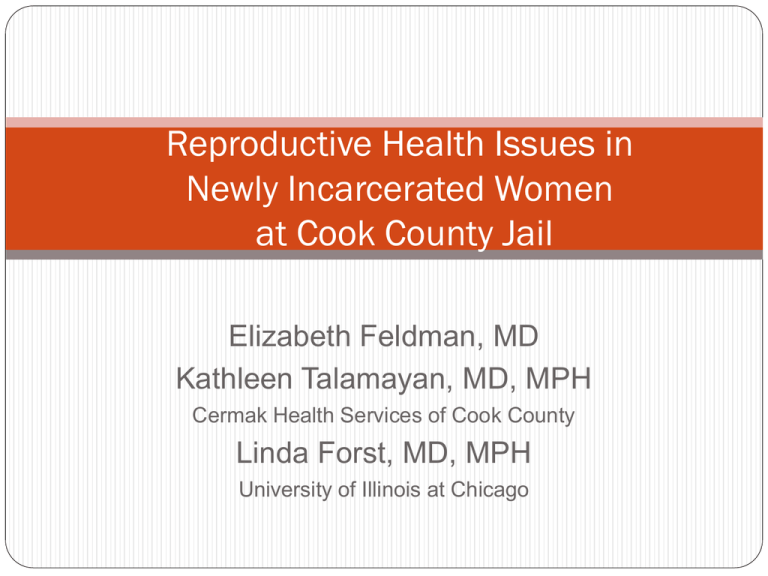
Reproductive Health Issues in
Newly Incarcerated Women
at Cook County Jail
Elizabeth Feldman, MD
Kathleen Talamayan, MD, MPH
Cermak Health Services of Cook County
Linda Forst, MD, MPH
University of Illinois at Chicago
Acknowledgments
Adina Goldberger, MS2, Miranda Hart, MD, and
Rose Kiken, BSN served as research assistants
Carolyn Sufrin, MD for her 2010 NCCHC
presentation and willingness to permit us to adapt
her survey instrument
Cook County Department of Corrections
Case
37 yo G4P2002 c/o opioid withdrawal
Multiple arrests for retail theft, PCS, prostitution
Unprotected vaginal intercourse in previous 5 days
Never used hormonal contraception
+GC dx last incarceration
+ regular tobacco use, + 3-4 bags intranasal heroin/d
Urine HCG negative
Background
Women represent the fastest growing prison
population (Greenfield and Snell,1999, Staton et al, 2003)
Incarcerated women are underserved and
socioeconomically disadvantaged (Covington,2007)
This population has reduced access to and
utilization of family planning services (US DHHS)
Background
In the US, 39m women are at risk for unplanned
pregnancy (Clark et al, 2006a)
Of those women at risk for unplanned pregnancy,
67% report inconsistent use of birth control (Clark et al,
2006a)
Despite OTC availability, emergency contraception
(EC) is underutilized (Devine,2012)
Only 4% of women ages 15-44 who have ever had
sexual intercourse have used EC (CDC, 2005)
Public Health Opportunity
Jail setting is a unique access point for high risk
women
Opportunity to provide reproductive health
education and services including contraception
Provision of EC at entry may impact unintended
pregnancies in incarcerated women
Offering birth control services pre-release improves
likelihood of initiating contraceptive use after release
(Clarke, 2006b)
Objectives
Explore reproductive health needs among newly
incarcerated urban women
Describe the knowledge, attitudes and practices
related to long term and emergency contraception
Discuss barriers to utilization of contraception
Advocate for policy change within Cook County
Jail to provide EC at entry and contraception prior
to release
Methodology
Design: Cross-sectional
Participants: newly incarcerated women, 18-50 yo
Recruitment: convenient nights, 33 occasions over
14 month period
Survey: 41 items, face to face interview
Data: frequency analysis
Human Subjects: CCBHCS IRB protocol for
research on incarcerated subjects
Results: Demographics
Newly incarcerated women,
18-50 years
June 2011-August 2012
Study
n=194
Jail, Overall
n=11,229
Age
30.8 ± 8.7 yo
29 yo
32.1± 9.4yo
31 yo
Race/ethnicity
African American
White, non-Hispanic
Hispanic +Other
121 (62.4%)
54 (27.8%)
36 (18.6%)
67.2%
19.8%
12.8%
Education
<HS
HS grad
>HS
50 (25.8%)
125 (64.4%)
19 ( 9.8%)
Average
Median
Results: Pregnancy History (n=194)
Number of live births:
None
One
Two
Three
Four or more
53
40
30
24
47
27%
20%
15%
12%
24%
Number of abortions
None
One
Two or more
112
41
41
58%
21%
21%
Think I am pregnant
14
7%
9
5%
Actually pregnant (by
uHCG)
Results: Pregnancy ‘Intention’
Of total
(194)
%
Of those at %
risk (146)
31/194
16
28/146
19
Does not desire 83/194
pregnancy
43
81/146
56
Undecided
28/194
14
27/146
19
No answer
52/194
27
10/146
7
Desires
pregnancy
Results: At risk for pregnancy(137) :
Had sex in last 5 days (n=61)
44.5%
Did not use any contraception (n=40/61)
65.6%
Used condoms every time (n=15/61)
24.6%
Subject to rape, forced or survival sex (n=11/61)
18.0%
Drunk or high while having sex (n=25/61)
41.0%
Results: Knowledge, Attitude and Practices
of Women Regarding EC
Category
# of
Percent
Participa distributio
nts
n%
Knowledge Think a women can prevent pregnancy a 141/194 72.7%
few days after unprotected sex
Have heard of EC
156/193 80.8%
Think EC is safe to use
53/158 33.5%
Think EC is good in preventing
64/158 40.5%
pregnancy
Thinks EC can cause abortion
65/158 41.1%
Attitude
Will accept free EC if offered today
135/194 69.6%
Practice
Will accept free EC at release from jail
158/194
81.4%
Interested in learning more about EC
120/194
61.9%
42/194
21.6%
Have used EC
Knowledge about how to prevent
pregnancy after sex
Yes
Can a woman prevent pregnancy a
few days after unprotected sex?
141 (72.7%)
How?
Take a pill 127/141 (90.1%)
Home remedy
7/141 (5.0%)
Abortion 28/141 (19.9%)
Listed other ways: take pill, hot
bath, douche, pee, go to doctor, get
shot, squeeze out, patch
No/Don’t Know
53 (27.3%)
Barriers to Use of EC
Reasons for Refusal of EC # of
participants
Brings up religious concerns 7
Do not mind being pregnant 30
Do not like medication
9
Worried about safety/side
effects
22
Want to talk to provider first
16
Other (won’t take in jail (3),
think can’t get pregnant (3))
12
Results: Attitudes and Practices
regarding Contraception
Wanted birth control in past year
44%
Saw provider in past year about birth
control
39%
Did not use any reversible method in
past year
63%
Currently using hormonal method (shot,
OC, patch, ring)
11%
Will accept free birth control upon
release
80%
Birth Control Method Use
Type of Birth
Control
Current Use
Within past
year
Surgical
IUD
Subdermal implant
34
7
2
Not asked
9
2
Long-acting
12
progestin (The Shot)
Combined pill, patch 7
or vaginal ring
32
Spermicide
None
0
123
0
138
34
Discussion: EC at Intake
66% of those who had had recent sex
reported it was unprotected
21% of our sample had unprotected sex within
previous 5 days
70% of our sample would take EC if offered
As many as 1982 women annually may be
eligible for EC at entry to Cook County jail
As many as 1387 doses may be dispensed
Discussion: Birth Control Services
Majority of women did not wish to become
pregnant
Majority wanted to use birth control
Only about 1/3 had used any birth control
in the past year, and a much smaller
number were currently using hormonal
contraception
Most women would accept free birth
control prior to release from jail
Discussion
Newly incarcerated women are at high risk for
unintended pregnancy
Knowledge about EC and ability to access birth
control services are both significantly limited
Other studies show that interventions during
incarceration work (Clarke, et al)
During incarceration there is an opportunity to
provide sex education - “teachable moment”
Recommendations: Intake
Intake screening to identify women at risk
for unintended pregnancy during previous
three to five days
Intake providers educated about use and
provision of emergency contraception
Emergency contraception immediately
available during Intake to jail for those
women who desire it
Recommendations: Birth Control
Implement reproductive health
education for incarcerated women
Provide opportunity to meet with health
care provider to discuss contraceptive
choices for those who desire
Offer birth control services prior to
release
Limitations of the Study
Study based on convenience sample may not be
representative of all incarcerated women
Small sample size
Self report data introduces some bias
Utilized frequency analysis
Case, continued
Pt urine + chlamydia
PAP showed ASCUS, cannot r/o HGSIL
colpo with LGSIL, cryo performed
Educated about contraceptive choices by PCP,
chose to start depo-Provera
Provider ordered first depo shot to be administered
day before next court date (expected release date)
Pt received depo, but was not released until 6 weeks
later, with info about Family Planning Clinic walk-in
options at Stroger Outpatient
References
Baldwin, K., & Jones, J. (2000). Health issues specific to incarcerated women: Information for state maternal and
child health programs. Retrieved from http://www.jhsph.edu/research/centers-and-institutes/womens-and-childrenshealth-policy-center/publications/prison.pdf
Center for Disease Control and Prevention. (2005). Fertility, family planning, and reproductive health of US. women:
Data from the 2002 national survey of family growth. Vital and Health Statistics, 23(25), 1-180.
Clarke, J. G., Hebert, M. R., Rosengard, C., Rose, J. S., DaSilva, K. M., & Stein, M. D. (2006a). Reproductive health
care and family planning needs among incarcerated women. American Journal of Public Health, 96(5), 834-839.
Clarke, J. G., Phillips. M., Tong, I., Rose, J., & Gold, Melanie, G. (2010). Timing of conception for pregnant women
returning to jail. Journal of Correctional Health Care, 16(2), 133-138.
Clarke, J. G., Rosengard, C., Rose, J. S., Hebert, M. R., Peipert, J., & Stein, M. D. (2006b). Improving birth control
service utilization by offering services prerelease vs postincarceration. American Journal of Public Health, 96(5),
840-845.
Clarke, J. G., Rosengard, C., Rose, J., Hebert, M. R., Phipps, M. G., & Stein, M. D. (2008). Pregnancy attitudes and
contraceptive plans among women entering jail. Women & Health, 43(2), 111-130.
Covington, S. (2007). Women and the criminal justice system. Women's Health Issues, 17(4), 180-82.
Crandall, L. A., Metsch, L. R., McCoy, C. B., Chitwood, D. D., & Tobias, H. (2003). Chronic drug use and
reproductive health care among low-income women in Miami, Florida: A comparative study of access, need, and
utilization. Journal of Behavioral Health Sciences Research, 30(3), 312-331.
References
Devine, K. S. (2012). The underutilization of emergency contraception. American Journal of Nursing, 112(4), 4450.
Department of Health and Human Services. (2012, Sept. 6). Family Planning. Retreived from
http://www.healthypeople.gov/2020/topicsobjectives2020/overview.aspx?topicid=13
Greenfeld, L.A., & Snell, T. L. (1999). Women Offenders. Washington, D.C.: Bureau of Justice Statistics.
Hale, G. J., Oswalt, K. L., Cropsey, K. L., Villalobos, G. C., Ivey, S. E., & Matthews, C. A. (2009). The
contraceptive needs of incarcerated women. Journal of Women's Health, 18(8), 1221-226.
LaRochelle, F., Castro, C., Goldenson, J., Tulsky, J. P., Cohan, D. L., Blumenthal, P. D., & Sufrin, C.B. (2012).
Contraceptive use and barriers to access among newly arrested women. Journal of Corrective Health Care,
18(2), 111-119.
Oswalt, K., Hale, G. J., Cropsey, K. L., Villalobos, G. C., Ivey, S. E., & Matthews, C. A. (2010). The contraceptive
needs for STD protection among women in jail. Health Education & Behavior, 37(4), 568-579.
Prine, L. (2007) Emergency contraception, myths and facts. Obstetrics and Gynecology Clinics of North America,
37(1), 127-36.
References
Staton, M., Leukefeld, C., & Webster, J. M. (2003). Substance use, health, and mental health: problems
and service utilization among incarcerated women. International Journal of Offender Therapy and
Comparative Criminology, 47(2), 224-239.
Sufrin, C. B., Creinin, M. D., & Chang, J. C. (2009). Contraception services for incarcerated women: A
national survey of correctional health providers. Contraception, 80, 561-565.
Sufrin, C. B., Tulsky, J. P., Goldenson, J., Winter, K. S., & Cohan, D.L. (2010). Emergency contraception
for newly arrested women: Evidence for an unrecognized public health opportunity. Journal of Urban
Health, 87(2), 244-53.
THANK YOU

